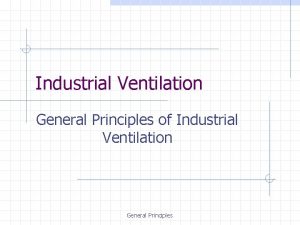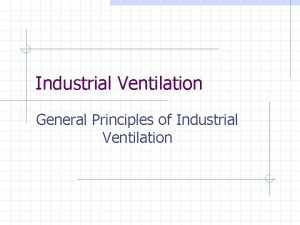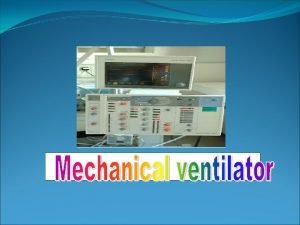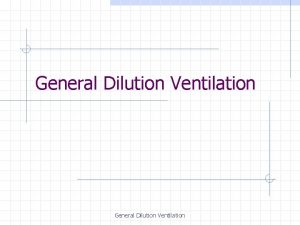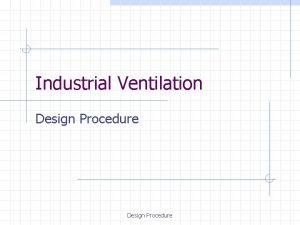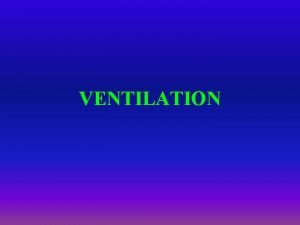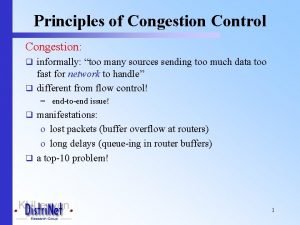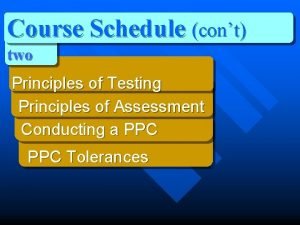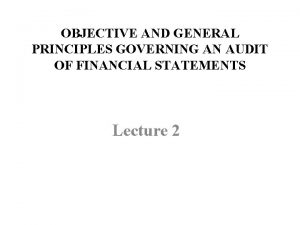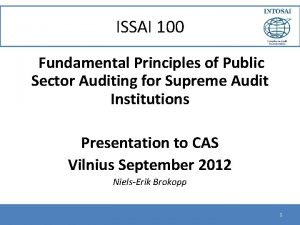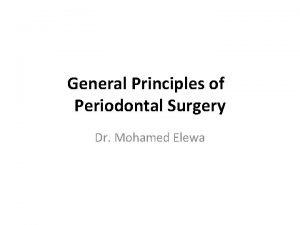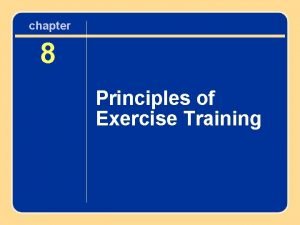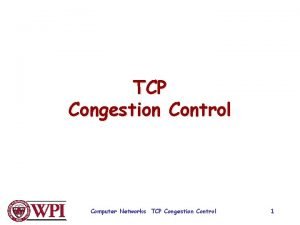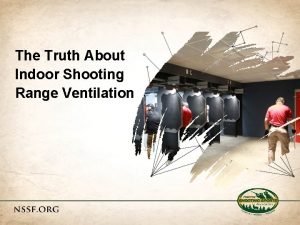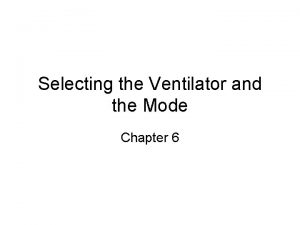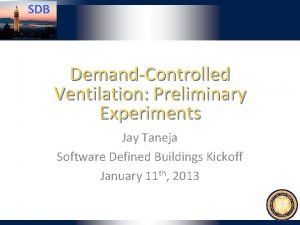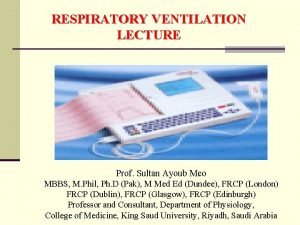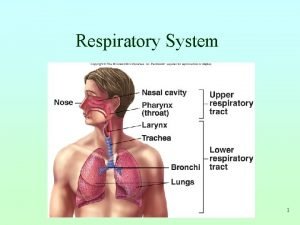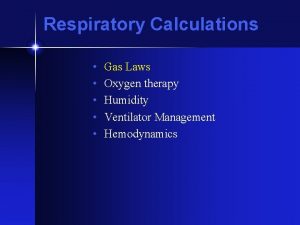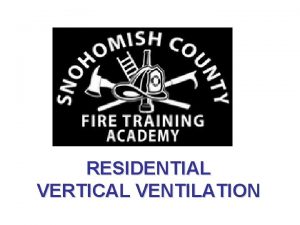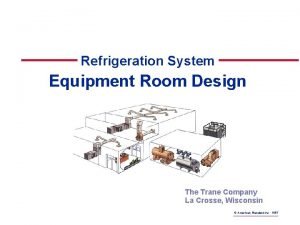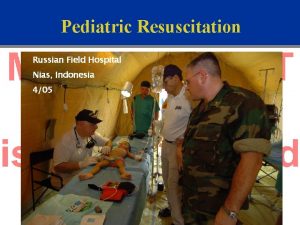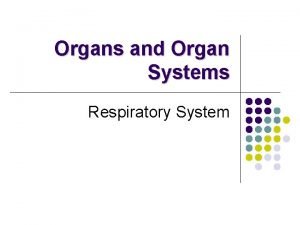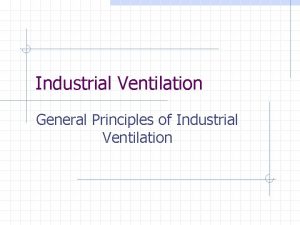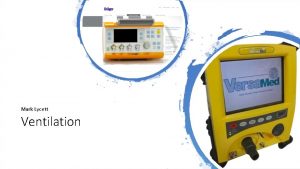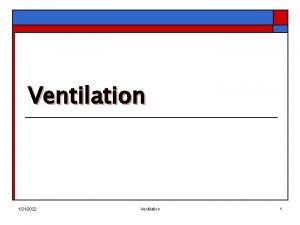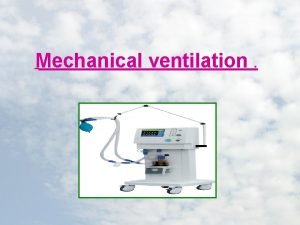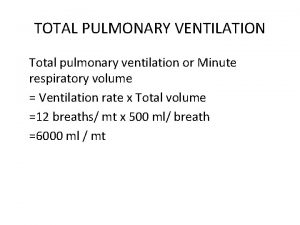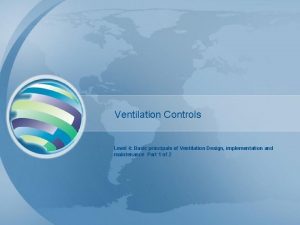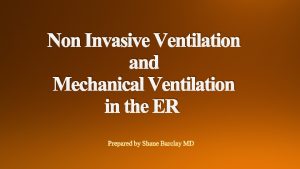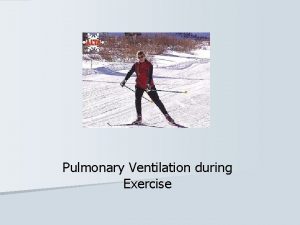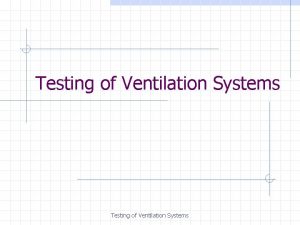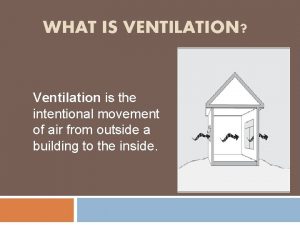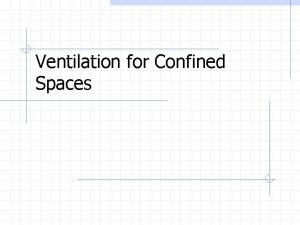Industrial Ventilation General Principles of Industrial Ventilation What





































- Slides: 37

Industrial Ventilation General Principles of Industrial Ventilation

What Is Industrial Ventilation? v Environmental engineer’s view: The design and application of equipment for providing the necessary conditions for maintaining the efficiency, health and safety of the workers v Industrial hygienist’s view: The control of emissions and the control of exposures v Mechanical engineer’s view: The control of the environment with air flow. This can be achieved by replacement of contaminated air with clean air General Principles 2

Industrial Ventilation Objectives v To introduce the basic terms v To discuss heat control v To design ventilation systems General Principles 3

Why Industrial Ventilation? v To maintain an adequate oxygen supply in the work area. v To control hazardous concentrations of toxic materials in the air. v To remove any undesirable odors from a given area. v To control temperature and humidity. v To remove undesirable contaminants at their source before they enter the work place air. General Principles 4

Application Of Industrial Ventilation Systems v Optimization of energy costs. v Reduction of occupational health disease claims. v Control of contaminants to acceptable levels. v Control of heat and humidity for comfort. v Prevention of fires and explosions. General Principles 5

Solutions To Industrial Ventilation Problems v Process modifications v Local exhaust ventilation v Substitution v Isolation v Administrative control v Personal protection devices v Natural ventilation General Principles 6

Ventilation Design Parameters v Manufacturing process v Exhaust air system & local extraction v Climatic requirements in building design (tightness, plant aerodynamics, etc) v Cleanliness requirements v Ambient air conditions v Heat emissions v Terrain around the plant v Contaminant emissions v Regulations General Principles 7

Source Characterization v Location v Relative contribution of each source to the exposure v Characterization of each contributor v Characterization of ambient air v Worker interaction with emission source v Work practices General Principles 8

Types Of Industrial Ventilation Systems Supply systems Purpose: v To create a comfortable environment in the plant i. E. The HVAC system v To replace air exhausted from the plant i. E. The replacement system General Principles 9

Supply Systems Components v Air inlet section v Filters v Heating and/or cooling equipment v Fan v Ducts v Register/grills for distributing the air within the work space General Principles 10

Exhaust Systems Purpose v An exhaust ventilation system removes the air and airborne contaminants from the work place air v The exhaust system may exhaust the entire work area, or it may be placed at the source to remove the contaminant at its source itself General Principles 11

Exhaust Systems Types of exhaust systems: v General exhaust system v Local exhaust system General Principles 12

General Exhaust Systems v Used for heat control in an area by introducing large quantities of air in the area. The air may be tempered and recycled. v Used for removal of contaminants generated in an area by mixing enough outdoor air with the contaminant so that the average concentration is reduced to a safe level. General Principles 13

Local Exhaust Systems(LES) v The objective of a local exhaust system is to remove the contaminant as it is generated at the source itself. Advantages: v More effective as compared to a general exhaust system. v The smaller exhaust flow rate results in low heating costs compared to the high flow rate required for a general exhaust system. v The smaller flow rates lead to lower costs for air cleaning equipment. General Principles 14

Local Exhaust Systems(LES) Components: v Hood v The duct system including the exhaust stack and/or re-circulation duct v Air cleaning device v Fan, which serves as an air moving device General Principles 15

What is the difference between Exhaust and Supply systems? An Exhaust ventilation system removes the air and air borne contaminants from the work place, whereas, the Supply system adds air to work room to dilute contaminants in the work place so as to lower the contaminant concentrations. General Principles 16

Pressure In A Ventilation System v Air movement in the ventilation system is a result of differences in pressure. v In a supply system, the pressure created by the system is in addition to the atmospheric pressure in the work place. v In an exhaust system, the objective is to lower the pressure in the system below the atmospheric pressure. General Principles 17

Types Of Pressures In A Ventilation Systems Three types of pressures are of importance in ventilation work. They are: v Static pressure v Velocity pressure v Total pressure General Principles 18

Why is air considered incompressible in Industrial Ventilation design problems? The differences in pressure that exist within the ventilation system itself are small when compared to the atmospheric pressure in the room. Because of the small differences in pressure, air can be assumed to be incompressible. Since 1 lb/in 2 = 27 inches of water, 1 inch = 0. 036 lbs pressure or 0. 24% of standard atmospheric pressure. Thus the potential error introduced due to this assumption is also negligible. General Principles 19

Velocity Pressure v It is defined as that pressure required to accelerate air from rest to some velocity (V) and is proportional to the kinetic energy of the air stream. v VP acts in the direction of flow and is measured in the direction of flow. v VP represents kinetic energy within a system. v VP is always positive. General Principles 20

Static Pressure v. It is defined as the pressure in the duct that tends to burst or collapse the duct and is expressed in inches of water gauge (“wg). v SP acts equally in all directions v SP can be negative or positive General Principles 21

Static pressure can be positive or negative. Explain. Positive static pressure results in the tendency of the air to expand. Negative static pressure results in the tendency of the air to contract. For example, take a common soda straw, and put it in your mouth. Close one end with your finger and blow very hard. You have created a positive static pressure. However, as soon as you remove your finger from the end of the straw, the air begins to move outward away from the straw. The static pressure has been transformed into velocity pressure, which is positive. General Principles 22

Velocity Pressure VELOCITY PRESSURE (VP) VP = (V/4005)2 or V = 4005√VP Where VP = velocity pressure, inches of water gauge (“wg) V = flow velocity, fpm General Principles 23

Total Pressure TP = SP + VP v It can be defined as the algebraic sum of the static as well as the velocity pressures v SP represents the potential energy of a system and VP the kinetic energy of the system, the sum of which gives the total energy of the system v TP is measured in the direction of flow and can be positive or negative General Principles 24

How do you measure the Pressures in a ventilation system? The manometer, which is a simple graduated U-shaped tube open, at both ends, an inclined manometer or a Pitot tube can be used to measure Static pressure. The impact tube can be used to measure Total pressure. The measurement of Static and Total pressures using manometer and impact tube, will also indirectly result in measurement of the Velocity pressure of the system. General Principles 25

Basic Definitions Pressure v It is defined as the force per unit area. v Standard atmospheric pressure at sea level is 29. 92 inches of mercury or 760 mm of mercury or 14. 7 lb/sq. inch. General Principles 26

Basic Definitions Air density v It can be defined as the mass per unit volume of air, (lbm/ft 3 ). at standard atmosphere (p=14. 7 psfa), room temperature (70 F) and zero water content. The value of ρ=0. 075 lbm/ft 3 General Principles 27

Basic Definitions Perfect Gas Equation: P = ρRT Where P = absolute pressure in pounds per square foot absolute (psfa). ρ = gas density in lbm/ft 3. R = gas constant for air. T = absolute temperature in degree Rankin. For any dry air situation ρT = (ρT)std ρ = ρstd(Tstd/T) = 0. 075 (460+70)/T = 0. 075 (530/T) General Principles 28

Basic Definitions Volumetric Flow Rate The volume or quantity of air that flows through a given location per unit time Q=V*A or V = Q /A or A = Q/V Where Q = volume of flow rate in cfm V = average velocity in fpm A = cross-sectional area in sq. ft General Principles 29

Example The cross-sectional area of a duct is 2. 75 sq. ft. The velocity of air flowing in the duct is 3600 fpm. What is the volume? From the given problem A = 2. 75 sq. ft. V = 3600 fpm We know that Q=V*A Hence, Q = 3600 * 2. 75 = 9900 cfm General Principles 30

Basic Definitions Reynolds number R = ρDV/μ Where ρ = density in lbm/ft 3 D = diameter in ft V = velocity in fpm μ = air viscosity, lbm/s-ft General Principles 31

Darcy Weisbach Friction Coefficient Equation hf = f (L/d)VP Where hf = friction losses in a duct, “wg f = friction coefficient (dimensionless) L = duct length, ft d = duct diameter, ft VP = velocity pressure, ”wg General Principles 32

Duct Losses v. Types of losses in ducts v v Friction losses Dynamic or turbulence losses General Principles 33

Duct Losses v. Friction losses v. Factors effecting friction losses: v v v Duct velocity Duct diameter Air density Air viscosity Duct surface roughness General Principles 34

Duct Losses Dynamic losses or turbulent losses v Caused by elbows, openings, bends etc. In the flow way. The turbulence losses at the entry depends on the shape of the openings Coefficient of entry (Ce) v For a perfect hood with no turbulence losses Ce = 1. 0 I. E V = 4005 ce√VP = 4005 √VP General Principles 35

Duct Losses Turbulence losses are given by the following expression Hl= FN*VP Where FN = decimal fraction General Principles 36

Terminal Or Settling Velocity V = 0. 0052(S. G)D 2 Where D = particle diameter in microns S. G = specific gravity V = settling velocity in fpm General Principles 37
 General exhaust ventilation
General exhaust ventilation Local exhaust ventilation definition
Local exhaust ventilation definition Mode of ventilation
Mode of ventilation General shop safety rules
General shop safety rules Norwani ahmat
Norwani ahmat Dilution ventilation system
Dilution ventilation system Ventilasi di tempat kerja
Ventilasi di tempat kerja Industrial ventilation system design
Industrial ventilation system design Lev hood
Lev hood Diferencia entre gran plano general y plano general
Diferencia entre gran plano general y plano general Where did general lee surrender to general grant?
Where did general lee surrender to general grant? General and industrial management
General and industrial management Modified pen grasp
Modified pen grasp General principles of congestion control
General principles of congestion control General principles of prevention
General principles of prevention What are the general principles of congestion control
What are the general principles of congestion control General principles of congestion control
General principles of congestion control General receiving principles
General receiving principles General principles of catalysis
General principles of catalysis General principles of chemotherapy
General principles of chemotherapy General principles of testing
General principles of testing Qualification of auditor
Qualification of auditor What are the general principles of assessment
What are the general principles of assessment Issai standards
Issai standards General principles of periodontal surgery
General principles of periodontal surgery Principles of training program
Principles of training program General principles of congestion control
General principles of congestion control Gun range ventilation
Gun range ventilation Mode of ventilation
Mode of ventilation Ventilation sdb
Ventilation sdb Conducting zone vs respiratory zone
Conducting zone vs respiratory zone Respiration vs ventilation
Respiration vs ventilation Minute volume
Minute volume Ventilation terminology
Ventilation terminology Trane refrigerant monitor
Trane refrigerant monitor 405 field hospital
405 field hospital Compression depth for child
Compression depth for child Trachea lining
Trachea lining
